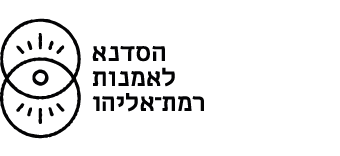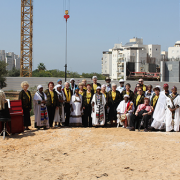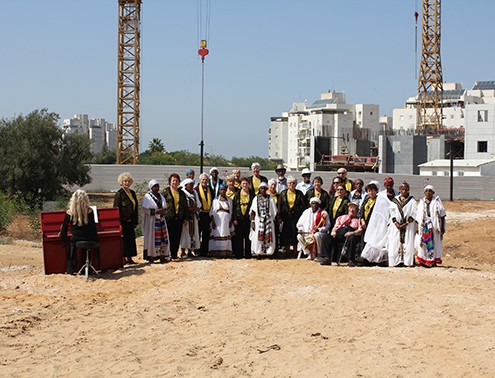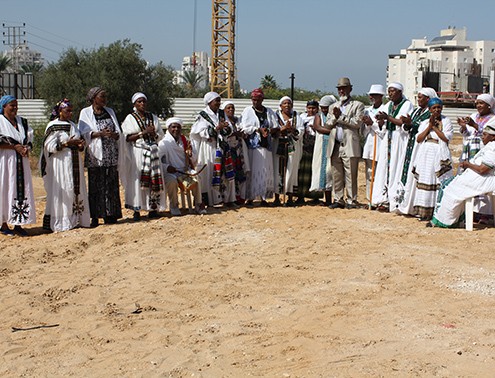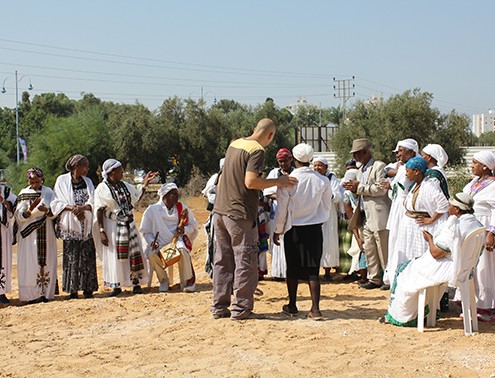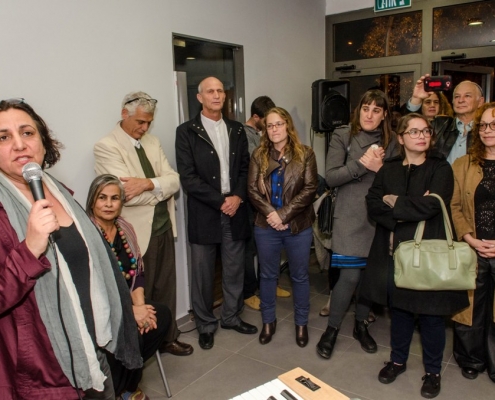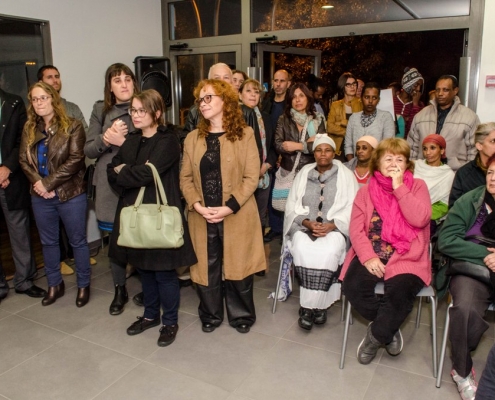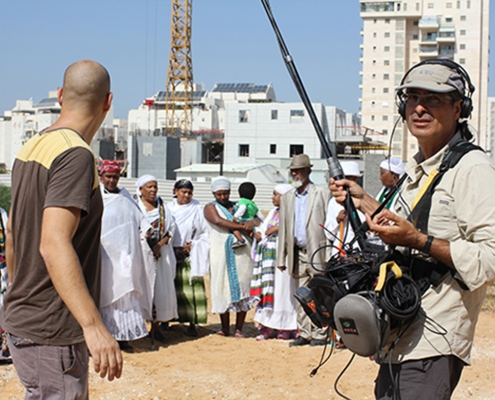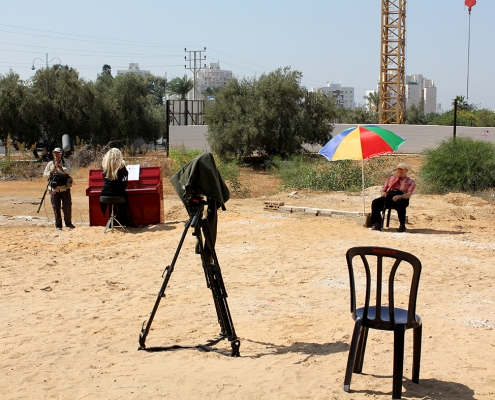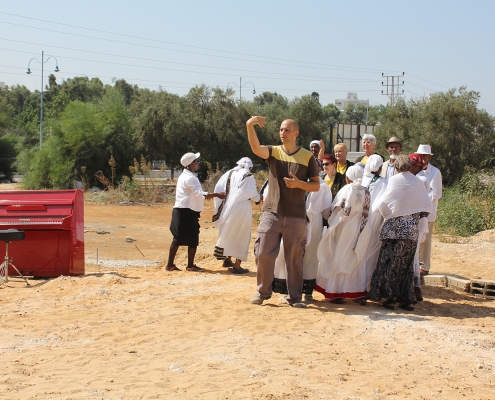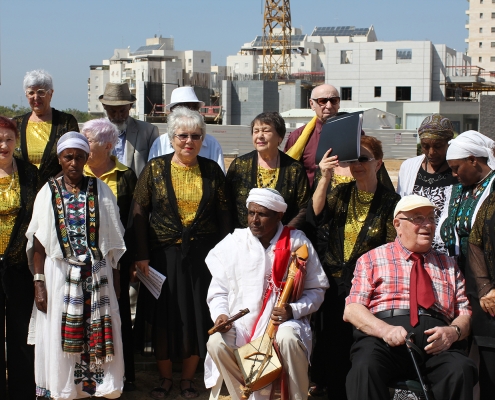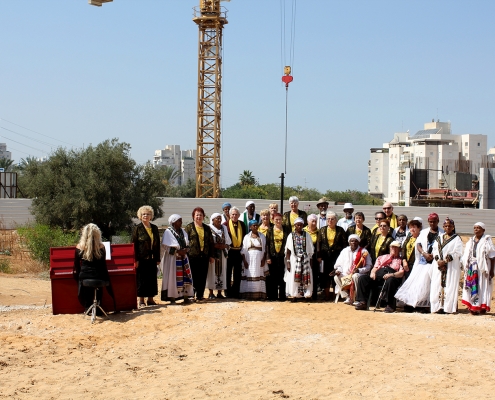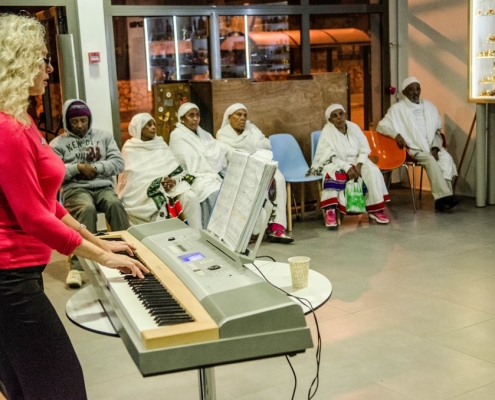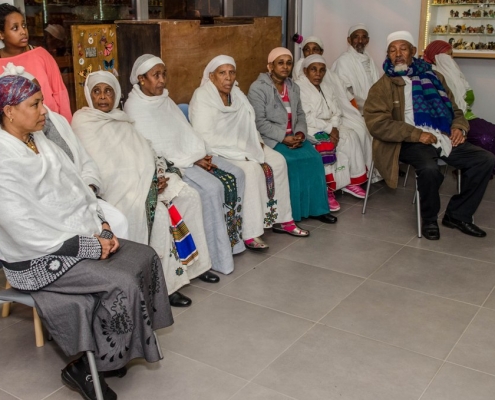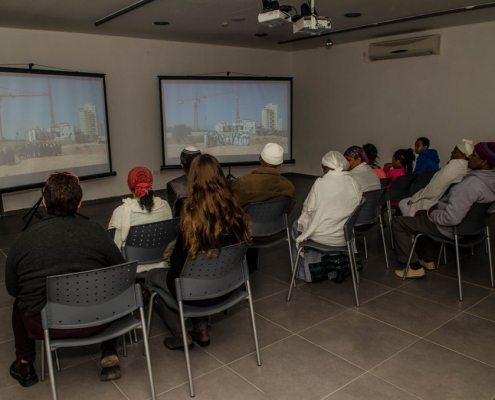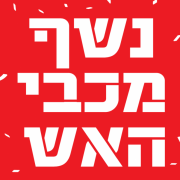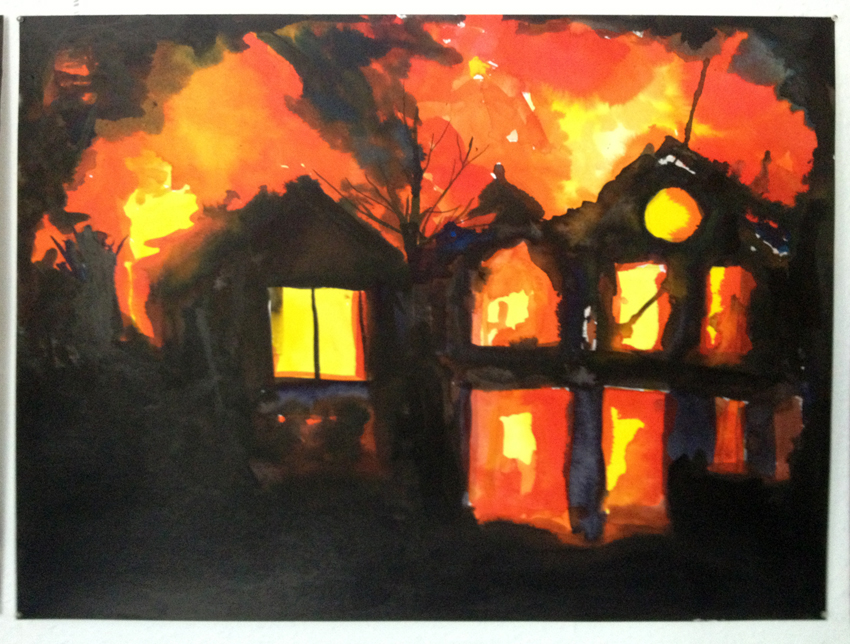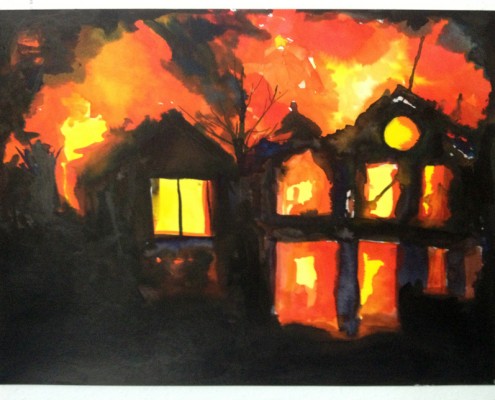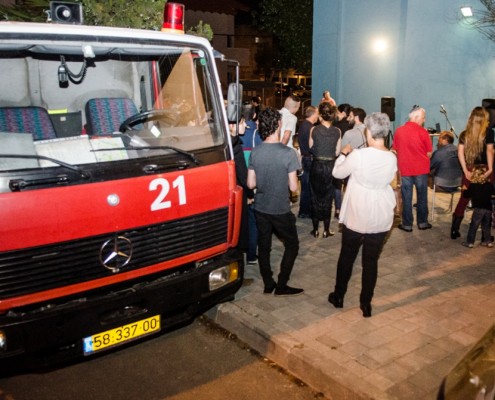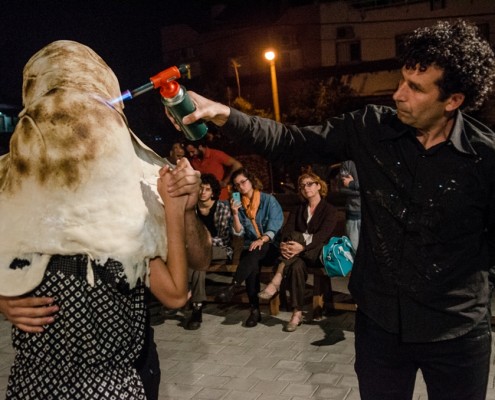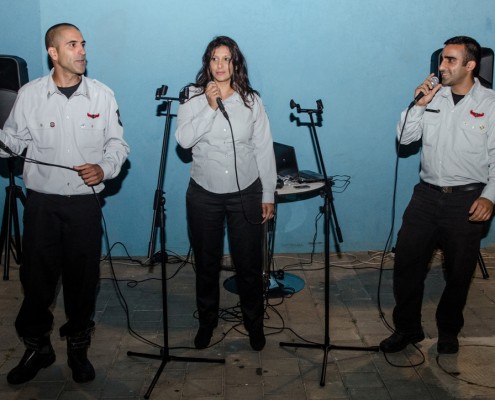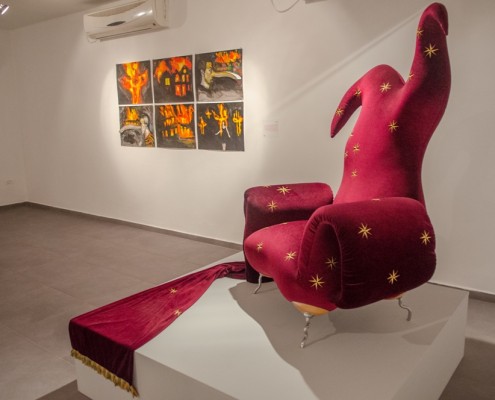בחולות , תערוכה | In the Sands , Exhibition
בתערוכתו החדשה בגלריה של הסדנא לאמנות ברמת אליהו, מציג עודד הירש את מיצב הווידאו הדו-ערוצי :”בחולות”. מיצב זה, שנוצר במיוחד לתערוכה, הוא פרי שיתוף פעולה בין הירש לבין חברי מקהלת “הרמוניה” בבית העולה ראשון לציון ותלמידי האולפן לעברית במתנ”ס רמת אליהו.
המיצב “בחולות” מקפל בתוכו עקרונות וערכים קהילתיים ומבקש להפנות את המבט אל קהילות העולים של יוצאי אתיופיה וחבר העמים. קהילות אלו מהוות מרכיב מרכזי באוכלוסיית העיר ראשון לציון בכלל ושכונת רמת אליהו בפרט, שכונה שמאז הקמתה משמרת את צביונה כקולטת עלייה ומרבית מתושביה הם עולים חדשים וותיקים יוצאי חבר העמים ואתיופיה.
על רקע תנופת בנייה עירונית, נוף זרוע מנופים וחולות צהובים (אשר ככל הנראה ישמשו גם הם אתרי בניה בעתיד הקרוב), מציב הירש שתי מקהלות זמר – אתיופית ורוסית – שחבריהן לבושים במיטב מחלצותיהם, עומדים בחצי גורן ברשמיות חגיגית ושרים שיר עם בשפת אימם. כך מיצר הירש פריים סוריאליסטי באמצעותו הוא נועץ שיניים בהוויה היומיומית הקונקרטית. ההתנגשות בין נוף פרברי-ישראלי לבין חברי שתי המקהלות על תלבושותיהם המסורתיות ממחישה את זרותם ביחס למקום, מקום בו הם נאבקים בכדי להכות שורשים.
הירש יוצר ב”תנאי מעבדה” מלאכותיים מפגש רב-תרבותי בין שתי קהילות עולים שלרוב אינן באות באינטראקציה זו עם זו, על אף שכנותן הפיזית ושותפות הגורל שהן חולקות. המפגש על הסט של הירש מייצג את הייחודיות של כל קבוצה אך גם את ההבדלים בין השתיים ומייצר באופן ישיר או עקיף התנגשות אתנית ותרבותית המנציחה נתק ושונות חברתית ומעלה ספק בנוגע ליכולת למיזוג ולגישור.
עודד הירש נולד בקיבוץ אפיקים ב- 1976 והינו אמן רב-תחומי הפועל בעיקר בתחומי הווידאו, הצילום והמיצב. הירש עוסק בסוגיות הבוחנות את מוטיב הקבוצתיות והקהילתיות כפי שהן משתקפות במצבים האבסורדיים שהוא יוצר ומביים.
הירש בוגר תואר שני ממכון פראת בניו יורק וקיבל מלגות הצטיינות רבות, בין היתר מקרן ג’רום לעידוד קולנוע ניסיוני, הארגון לתרבות יהודית באמריקה, העמותה לקידום אמנות בניו יורק ועוד. עבודותיו הוצגו בארץ בין היתר במוזיאון ישראל, מוזיאון רמת גן, מוזיאון פתח תקוה, המשכן לאמנות עין חרוד ועוד. הירש הציג תערוכות יחיד והשתתף בתערוכות קבוצתיות ברחבי העולם וזכה לביקורות נלהבות וסיקור תקשורתי נרחב בארץ (ערוץ 10, ידיעות אחרונות, מעריב, הארץ ועוד) ובעולם (New York Times, ArtForum, New York Magazine ועוד).
מידע נוסף ניתן למצוא באתר: www.odedhirsch.co
In the Dunes
Oded Hirsch
November 2014 – March 2015
Oded Hirsch’s new exhibition at The Art workshop Ramat Eliyahu Gallery features a two channel video installation titled In the Dunes. Hirsch’s video installation created especially for this show was made in collaboration with members of “Harmony”, a veteran’s choir from Beit Ha-Ole Rishon LeZion and a class of the Hebrew “Ulpan” from the community center of Ramat Eliyahu. In the Dunes focuses on communal values and seeks to reexamine common perception of Russian and Ethiopian emigrants communities, key ingredients in Rishon LeZion’s population in general and Ramat Eliyahu neighborhood particularly.
Hirsch’s working practice is generally concentrated on the community as an organism; gathering large groups of people working jointly in order to fulfill a mutual goal. Oftentimes the purpose is not entirely clear and the motivation is driven neither by ideology nor by self-interest, but for the sole pleasure derived from the communal act of “togetherness”. By staging ambiguous situations, Hirsch investigates the existing dynamics within the group, the engrained tension between its individuals and the shared values that lay underneath their unification. Unlike his previous works, in which the particulars identities were unclear and their presence depended on the whole group, in this work another dimension of social specification is being developed.
In his new piece Hirsch captures a group of distinctive individuals with a homogeneous background which represents socio-economically challenged characteristics. He transforms his communal approach into a reflective process by discussing utopic social situations as well as establishing a critical platform based on Politics of Identity. Hirsch points out the expanding gap between marginal and cultural hegemony, past and present, ideology and reality. These frictions in Hirsch’s work raise misgivings regarding the certainty of the Zionist dream in contemporary Israeli reality.
Against the widespread scenery of urban construction triumph, Hirsch situates two choirs, Ethiopian and Russian, in a landscape adorned by cranes and sand dunes that will be probably transformed in the near future into another building lot. The performers all dressed up in their finest clothing; sing festively, each one in turn, a chant in their mother tongue. The clash between the Israeli suburban landscape and the members of the two choirs, who are dressed with traditional garments, is emphasized by their alienation towards the place in which they struggle to put down roots in.
By creating surrealistic situation, Hirsch confronts the daily elements of a concrete reality. Examining these two dominant communities living in Ramat Eliyahu since the 90’s, Hirsch points out a socio-cultural deficiency. Despite being a major demographical component in the city’s population, the Russian and Ethiopian communities do not receive adequate cultivation and therefore find themselves completely immersed in a cultural chaos.
Furthermore, under “controlled laboratory conditions” Hirsch creates an artificial multi-cultural encounter between these two emigrant’s groups that usually do not interact with each other, in spite of their geographical proximity and the difficulties they essentially share. This encounter on Hirsch’s set underlines the uniqueness of each group, as well as their great differences. It shows an ethnic, religious and cultural clash that perpetuates a social gap that cannot easily be bridged.
With this video installation Hirsch joins a long tradition of artists who deal with the image and the cultural implications of immigration. However, unlike artists such as Adrian Paci, Fiona Tan, Ezra Erzen and others, Hirsch’s main interest do not concern socio-political context of migration in global times, but rather focuses on the unique angle of the local Israeli society narrative.
The positioning of two screens side by side alludes to stylized Zionist propaganda postcards and can be seen as an echo of the local ethos of making the desert bloom. However, cracks are revealed soon enough in this flashy ideology. The sharp contrast between the captivating humoristic choir’s representation and the location they are being situated in, hints towards foreignness and dislocation rather then ideal harmony.
Hirsch’s decision to explore themes of immigration and integration through a musical context of singing choirs, is a homage to the cultural heritage of these communities and emphasizes the importance of heritage preservation. During the years, several musical groups from Russian and Ethiopian origin were active in Rishon LeZion, some independently and some under the support of the municipality and governmental institutions. Today, only a few of them still operate (1) while others stopped their practice due to an insufficient financial support (2).
Curator: Sally Haftel Naveh
_____________________________________________________________________________________________
(1) “Harmony” Choir from Beit HaOle under the guidance of Larisa Nikol, “Hatikva” Choir from Olim Club under the guidance of Yelena Krinsky, both comprised of elder population from Russian origin. Ethiopian groups include independent group “Argev” and “No Name” (a group of younger musicians supported by the Israel Anti–Drug authority and guided by Yovav Shalit)
(2) The young musical group “Infinity” under the support of the Israel Anti –Drug authority and the guidance of Yovav Shalit was active till 2010 and the independent group “Andemat” was active until few months ago, both groups from Ethiopian origins.
פתיחה יום שבת, 29.11.14
אמנים עודד הירש
אוצרות סאלי הפטל נוה
מנהלת ואוצרת ראשית של הסדנא אורית חסון ולדר
